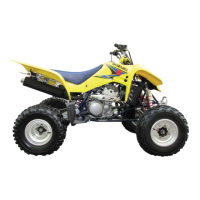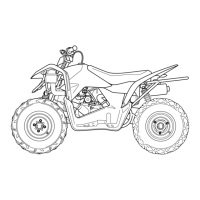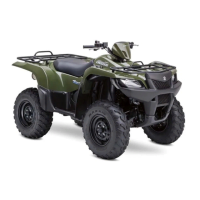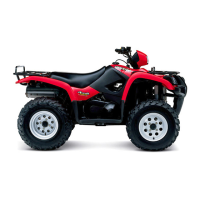CHASSIS 5-9
• When installing each tire, make sure the arrow A on the tire
points in the direction of rotation. Also, make sure the outer
side of the wheel rim is facing outward.
NOTE:
For inspecting the tires, refer to page 2-18.
Inspect the valve cores, before installing.
• Inflate the tire to seat the tire bead.
Maximum tire bead seat pressure
Front : 250 kPa (2.5 kgf/cm², 36 psi)
Rear : 250 kPa (2.5 kgf/cm², 36 psi)
NOTE:
Check the “rim line” 1 cast on the tire sidewalls. It must be equi-
distant from the wheel rim all the way around. If the distance
between the rim line and the wheel rim varies, this indicates that
the bead is not properly seated. If this is so, deflate the tire com-
pletely and unseat the tire bead on both sides. Then, coat the
bead with clean water and re-seat the tire.
• Adjust the tire pressure to the specified pressure.
Cold inflation tire pressure
Front : 20 kPa (0.20 kgf/cm², 2.9 psi)
Rear : 20 kPa (0.20 kgf/cm², 2.9 psi)
Vehicle load capacity: 38 kg (84 lbs)
Maximum operating pressure
✩: 25 kPa (0.25 kgf/cm², 3.6 psi)
✩✩: 35 kPa (0.35 kgf/cm², 5.1 psi)
✩✩✩: 45 kPa (0.45 kgf/cm², 6.5 psi)
Place the tire under a protective tire cage or similar
protective covering device before inflating the tire. To
minimize the possibility of tire damage when seating
the tire bead, never exceed the MAXIMUM TIRE BEAD
SEAT PRESSURE rating shown on the tire.
Before inflating the tire, check the MAXIMUM OPER-
ATING PRESSURE rating of the tire. This is indicated
by a “✩” following the tire size shown on the sidewall.
The number of “✩” on the tire indicates the maximum
operating pressure.
PartShark.com
877-999-5686
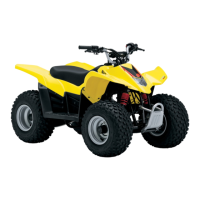
